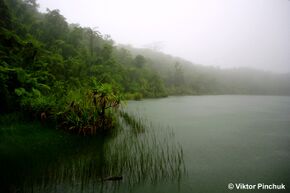Earth:Lake Lanoto'o
| Lake Lanoto'o | |
|---|---|
 Lake Lanoto'o | |
| Coordinates | [ ⚑ ] : 13°54′36.72″S 171°49′39.73″W / 13.9102°S 171.8277028°W |
| Type | Crater lake |
| Catchment area | 23 hectares (57 acres) |
| Max. length | 400 metres (1,300 ft) |
| Surface area | 11 hectares (27 acres) |
| Max. depth | 17 metres (56 ft) |
| Surface elevation | 760 metres (2,490 ft) |
Lake Lanoto'o is a volcanic crater lake on the island of Upolu in Samoa. It is the largest lake in Samoa.[1] The lake is surrounded by Lake Lanoto'o National Park and is designated as a wetland of international importance under the Ramsar Convention.[2]
The lake is 400 metres (1,300 ft) long with a maximum depth of 17 metres (56 ft) and an area of 11 hectares,[3] with a water temperature of 27.8 °C (82.0 °F) and a pH of 5.72.[4] The crater is between 100,000 and 1 million years old.[3]
Sediment cores from the lake have been used to date the human settlement of Upolu[5] and of Polynesia,[3] and to study the paleoclimate and past ecology of Upolu.[6]
The lake provides an important habitat for the Pacific black duck and Spotless crake.[1] Goldfish were introduced during the German colonial period.[1]
References
- ↑ 1.0 1.1 1.2 "Samoa". SPREP. pp. 12–16. https://www.sprep.org/attachments/bem/Samoa_Country_Chapter.pdf.
- ↑ "Lake Lanoto'o". Ramsar Sites Information Service. https://rsis.ramsar.org/ris/1412?language=en.
- ↑ 3.0 3.1 3.2 Sear, David A.; Allen, Melinda S.; Hassall, Jonathan D.; Maloney, Ashley E.; Langdon, Peter G. (16 June 2020). "Human settlement of East Polynesia earlier, incremental, and coincident with prolonged South Pacific drought". PNAS 117 (24): 2. doi:10.1073/pnas.2008788117. PMID 32513740. PMC 7306803. https://www.pnas.org/content/pnas/early/2020/03/31/1920975117.full.pdf. Retrieved 8 August 2021.
- ↑ Schabetsberge, Robert; Drozdowski, Gabriele; Rott, Eugen; Lenzenweger, Rupert; Jersabek, Christian D. (2009). "Losing the Bounty? Investigating Species Richness in Isolated Freshwater Ecosystems of Oceania". Pacific Science 63 (2): 156. doi:10.2984/049.063.0201. https://bioone.org/journals/pacific-science/volume-63/issue-2/049.063.0201/Losing-the-Bounty-Investigating-Species-Richness-in-Isolated-Freshwater-Ecosystems/10.2984/049.063.0201.full. Retrieved 8 August 2021.
- ↑ Gosling, William D.; Sear, David A.; Hassall, Jonathan; Langdon, Peter G.; Bönnen, Mick N. T. (2020). "Human occupation and ecosystem change on Upolu (Samoa) during the Holocene". Journal of Biogeography 47 (3): 600–614. doi:10.1111/jbi.13783.
- ↑ Parkes, Annette (1994). HOLOCENE ENVIRONMENTS AND VEGETATIONAL CHANGE ON FOUR POLYNESIAN ISLANDS (PDF) (PhD). University of Hull. p. 67-86. Retrieved 8 August 2021.
 |


